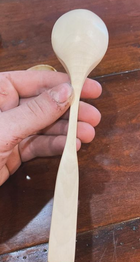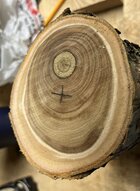As I get more invested and knowledgeable about our dear arboreal resources and the functionality of their flesh, I am curious about a few things. The two species I will refer to are Pacific crabapple and red alder. Alder cracks and warps less than the crabapple, but the phenomenon is bilateral: no cracking, and white. I have seen some other pictures of apple wood, which is light chocolate. Some crabapple is, but sometimes it is white, almost bone white (unless it has a purple-red heartwood). Alder has many different colors, from golden brown to light cream bone-white, or even yellow. I like the lighter color for some applications, especially on the crabapple, as it is so hard, it is like a holly, boxwood, or even bone. Why is it sometimes white, but sometimes not? Some variables I can isolate are how it is dried, kiln, bagged, boiled, and air-dried. What finish, shellac, oil, urethane, etc. However both crabapple and alder have had this happen, but I am not sure why. I have read about holly, and how the time it is exposed to the elements before it is dried is critical to avoid enzymatic staining, or even fungal. Also, kiln drying is better.
Another part is partially related to my questions about drying boxwood vs. mountain mahogany, but some pieces don't crack. I mean small branches/trunks/limbs, from ~1" to 3" on apple, and <6" on alder. Sometimes it splits, but other times it dries completely with no cracks, always accidental. At my school shop, there are alder logs, because it is the largest, most common, and hardest hardwood on our island. It has no sealant and is on the floor. It is dry, and sometimes has cracks, but sometimes has whole logs with no cracks, and a white color. Now, I found a piece of crabapple from about a year ago in a pile of scraps, one side had cracks halfway down the "log" and the other side had none. On a fruitwood? didn't think it was possible.
The question is, how do I get my alder and apple to be white and have no cracks in rounds 2-3" in diameter?
time of year? drying method? length of pieces? Sealant? Bark on or off?
Another part is partially related to my questions about drying boxwood vs. mountain mahogany, but some pieces don't crack. I mean small branches/trunks/limbs, from ~1" to 3" on apple, and <6" on alder. Sometimes it splits, but other times it dries completely with no cracks, always accidental. At my school shop, there are alder logs, because it is the largest, most common, and hardest hardwood on our island. It has no sealant and is on the floor. It is dry, and sometimes has cracks, but sometimes has whole logs with no cracks, and a white color. Now, I found a piece of crabapple from about a year ago in a pile of scraps, one side had cracks halfway down the "log" and the other side had none. On a fruitwood? didn't think it was possible.
The question is, how do I get my alder and apple to be white and have no cracks in rounds 2-3" in diameter?
time of year? drying method? length of pieces? Sealant? Bark on or off?
Last edited:


